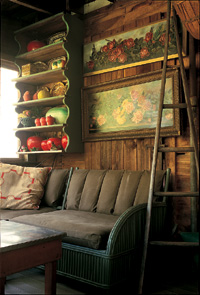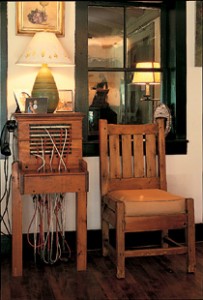by David Cathers

Elaine and Robert Dillof’s Maine vacation house makes you feel as if you’ve left the present century and stepped back several decades. As you move from one imaginatively decorated room to the next, you marvel at the authentic furnishings, the antique and semi-antique artifacts, the paintings on the walls and the whimsical, Maine-made folk art.
 It has a rambling layout and a comfortable, easy, lived-in aura, the kind only time can give. The kitchens, dining areas, winter and summer living rooms, and both screened and glassed-in porches make it a very livable house where family relaxes and guests feel at home. A master bedroom and bath are on the first floor, and upstairs there are seven bedrooms reachable by two sets of narrow stairs.
It has a rambling layout and a comfortable, easy, lived-in aura, the kind only time can give. The kitchens, dining areas, winter and summer living rooms, and both screened and glassed-in porches make it a very livable house where family relaxes and guests feel at home. A master bedroom and bath are on the first floor, and upstairs there are seven bedrooms reachable by two sets of narrow stairs.
This is a picturesque Maine lodge that has been lived in for 150 years, and walking through it you could easily believe that each succeeding generation has left some traces of itself behind.
Yet for all its captivating, patinated charm, it is not simply an enchanted survivor from another era. The interior of this comfortable old vacation house is a modern work of art, created over many years with visual daring and a spirited sense of fun by the talented, tenacious Elaine.
Sundial Manor and Cottages
 When the Dillofs’ four children were young, the family began summering in Maine, staying in rented houses. But one summer, more than 30 years ago, the idea came to them that instead of renting they could buy a second home of their own. Starting in the midcoast town of Damariscotta, they set off to explore. As was true of all their Maine travels, this was part pleasure — they loved visiting small towns and driving along little-traveled back roads — and part business, because Elaine is an antiques dealer who combs the state each summer buying for her Connecticut shop. Now, though, Elaine and Bob were also looking for a house.
When the Dillofs’ four children were young, the family began summering in Maine, staying in rented houses. But one summer, more than 30 years ago, the idea came to them that instead of renting they could buy a second home of their own. Starting in the midcoast town of Damariscotta, they set off to explore. As was true of all their Maine travels, this was part pleasure — they loved visiting small towns and driving along little-traveled back roads — and part business, because Elaine is an antiques dealer who combs the state each summer buying for her Connecticut shop. Now, though, Elaine and Bob were also looking for a house.
They soon found a house in one of the lake regions in Maine that had recently come onto the market. It was a large, circa 1840 New England farmhouse that for a number of years up to the 1950s had been a country inn called “Sundial Manor and Cottages.” Now it was empty and showing its age, along with its ramshackle barn. But it sat on five handsome acres bracketed by tall evergreens, with a long lawn sloping down to its own sandy beach at the edge of a peaceful lake. At the back of the house was an octagonal, one-room addition with a continuous band of windows, a high, beamed ceiling and a rustic brick fireplace, and it was this Arts and Crafts-looking part of the house that appealed most to Elaine. What the children liked best, though, were all those bedrooms, and they clambered upstairs to claim the ones they wanted for themselves. The Dillofs, it seemed, had no choice but to buy.
“Re-creating” an Old Maine Lodge
 The place needed work. The Dillofs put in a new kitchen, refurbished bathrooms and spruced everything up with necessary coats of paint. Other than taking down a wall between the kitchen and dining room and converting a log shed to a screened porch, they have made few changes to the structure of the house. For the past three decades they’ve vacationed here every summer. They swim, fish, boat, sun, read, cook and offer their bountiful hospitality to a constant flow of visiting family and friends. “The house needs to be alive with people,” says Elaine, and the Dillofs and their fortunate guests keep it happily animated all summer.
The place needed work. The Dillofs put in a new kitchen, refurbished bathrooms and spruced everything up with necessary coats of paint. Other than taking down a wall between the kitchen and dining room and converting a log shed to a screened porch, they have made few changes to the structure of the house. For the past three decades they’ve vacationed here every summer. They swim, fish, boat, sun, read, cook and offer their bountiful hospitality to a constant flow of visiting family and friends. “The house needs to be alive with people,” says Elaine, and the Dillofs and their fortunate guests keep it happily animated all summer.
Any house, especially one with so many rooms, needs furnishings and Elaine took charge of that task. She began the day of the closing. While Bob met with bankers and brokers, Elaine darted out to a local auction and bought the two-door Stickley bookcase that is still in the small room they call the winter living room. That first purchase aside, the Dillofs decided not to try to fill this house with Stickley furniture. They already had a considerable Arts and Crafts collection at their home in Westchester County, N.Y., and with their Maine vacation house they wanted to do something different, something fun. (The Dillofs’ Arts and Crafts collection is featured in Issue No. 30.) As they say today, “We tried to furnish this house as any family might have furnished it in the 1930s or 1940s. We wanted to ‘re-create’ it as a lodge in the feeling of old Maine.”
 To re-create something that never exactly existed requires creativity, imagination and an intuitively acute eye. And along with that artistic sensibility it demands sheer, tireless effort because furnishings suitable for an “old Maine” lodge can’t be found at a local mall. They are scattered across a widespread rural landscape, stacked up along with Everests of aging junk in small-town antiques shops, barns, garages, sheds and second-hand stores, or set out randomly on unkempt lawns at house sales and country auctions.
To re-create something that never exactly existed requires creativity, imagination and an intuitively acute eye. And along with that artistic sensibility it demands sheer, tireless effort because furnishings suitable for an “old Maine” lodge can’t be found at a local mall. They are scattered across a widespread rural landscape, stacked up along with Everests of aging junk in small-town antiques shops, barns, garages, sheds and second-hand stores, or set out randomly on unkempt lawns at house sales and country auctions.
Because of her persistence and dedication, matched by her uncanny knack for spying hidden gems, Elaine finds all sorts of wonderful old artifacts. A glimpse into any room in this house proves that point.
Look, for instance, at the former log shed by the kitchen that the Dillofs converted into a screened-in dining area. Against one all there’s a stylish, 1940s Moderne wicker couch, painted and reupholstered by Elaine. Next to it stands an old,triangle-shaped, whittled wooden ladder once used for climbing apple trees in some vast Maine orchard. Your eye naturally “climbs” thatladder to the two locally found Victorian-era rose paintings, one on canvas, one on wood, that hang beside it.
 To the left of the paintings, on a shelf with jigsaw-cut sides, you see a shiny red set of graduated canisters shaped like pneumatic apples, three big red and green dimpled strawberries that are actually china cups, and a life-size chalkware watermelon that dates to the late-19th century. And on the shelves above, there are more ceramic fruits and vegetables and a group of 19th-century plates and platters. These are not costly antiques (for instance: price of canister set, $3), but gathering such things takes uncommon talent and unstinting time.
To the left of the paintings, on a shelf with jigsaw-cut sides, you see a shiny red set of graduated canisters shaped like pneumatic apples, three big red and green dimpled strawberries that are actually china cups, and a life-size chalkware watermelon that dates to the late-19th century. And on the shelves above, there are more ceramic fruits and vegetables and a group of 19th-century plates and platters. These are not costly antiques (for instance: price of canister set, $3), but gathering such things takes uncommon talent and unstinting time.
The Beck Room
 Ninety or a hundred years ago it would not have been unusual to find Stickley furniture in a Maine camp, and there may well have been some in this one. Following that tradition, and yielding a little to their collectors’ impulse, the Dillofs have put Stickley chairs and a bookcase into the winter living room and filled the added-on octagonal living room almost entirely with Stickley and other handcrafted pieces. Its natural woodwork and substantial brick fireplace make it a harmonious space for Arts and Crafts furnishings. And this addition — originally constructed as a dining room for the inn — is itself an important chapter in the story of this house.
Ninety or a hundred years ago it would not have been unusual to find Stickley furniture in a Maine camp, and there may well have been some in this one. Following that tradition, and yielding a little to their collectors’ impulse, the Dillofs have put Stickley chairs and a bookcase into the winter living room and filled the added-on octagonal living room almost entirely with Stickley and other handcrafted pieces. Its natural woodwork and substantial brick fireplace make it a harmonious space for Arts and Crafts furnishings. And this addition — originally constructed as a dining room for the inn — is itself an important chapter in the story of this house.
Elaine and Bob call it “The Beck Room,” in honor of its designer and builder, Klir Beck. Beck, whose first name is pronounced “Clare,” lived from 1892 to 1966, and photographs of him show an unremarkable-looking man with a wiry build. He favored thick-framed eyeglasses and checkered flannel shirts, and sported a pencil-thin mustache. Yet despite his generally unassuming appearance, his face revealed a kind of concentrated intensity and he had powerful, dexterous hands. To people who knew his work, he was a genius, “Maine’s Modern Leonardo DaVinci,” as one of the state’s newspapers once called him. He was a painter, sculptor, designer and architect, an imaginative master craftsman adept with wood, metal, stone, glass and every other material he touched.
During the years that the Dillofs’ house was an inn, Beck was a friend of the owner and often took on projects for him, designing and constructing the octagonal wing as well as carving architectural elements and making furniture. He also designed, made and painted the whimsical “Sundial Manor and Cottages” sign that the Dillofs have brought inside to protect it from Maine’s winter weather. In part, this house celebrates the memory of Klir Beck.
The Spirit of the Place
 Though 50 years have passed since this was an inn with paying guests, a sense of welcome is still very strong here. Elaine and Bob greet their visitors with great warmth. The food and wine they serve are superb, the conversation is fun and free flowing, and it is impossible to spend time here without being caught up in the lively spirit of the place.
Though 50 years have passed since this was an inn with paying guests, a sense of welcome is still very strong here. Elaine and Bob greet their visitors with great warmth. The food and wine they serve are superb, the conversation is fun and free flowing, and it is impossible to spend time here without being caught up in the lively spirit of the place.
During the summer months there are six to eight guests all the time, and mentally toting up breakfasts, lunches and dinners, Bob approximates that in an average season Elaine must make about 1,000 meals. This may seem like an astonishing number, but to the Dillofs, hospitality is the heart and soul of the enterprise. For all its extraordinary decor, this is not a museum where you stand in hushed awe of amazing things. “This house is nothing to me,” Elaine admits, “unless it’s filled up with people.”
A group of guests recently enjoyed lunch on the screened porch. It was a glorious September day — crisp air, warm sun, light breezes weaving through the evergreens — and everyone felt at ease, expansive, embraced by the Dillofs’ friendliness and vivacity. Seated at the table, Elaine swept her arm around in a gesture that took in the house, the tall trees, and the blue triangle of lake visible at the end of the deep, green lawn. She smiled, her face lit with contentment. “This,” she said, “is our little slice of paradise.”











Recent Comments